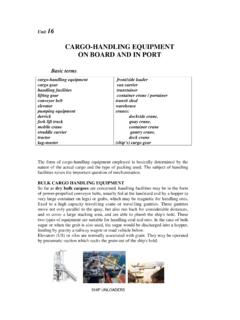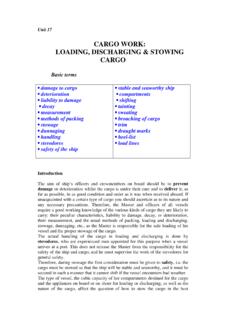Transcription of SHIP DESIGN AND CONSTRUCTION (general introduction) …
1 1 Unit 1 SHIPS AND SHIP TERMS SHIP DESIGN AND CONSTRUCTION ( general introduction ) Basic terms hull superstructure machinery stern bow amidships beam deck engine room propeller shaft bow thruster rudder bulbous bow hold 1 A multi-purpose vessel 2 An oil tanker 3 A container vessel 2 4 A roll-on/roll-of ship 5 bulk carrier - elevation / profile 6 A bulkcarrier upper/main deck plan Ships are large, complex vehicles which must be self-sustaining in their environment for long periods with a high degree of reliability. A ship is the product of three main areas of skill, those of the naval architect , the navigating officer (deck officer) and the marine engineer (engineering officer).
2 The naval architect is concerned with the hull, its CONSTRUCTION , form, habitability and ability to endure its environment. The navigating officer is responsible for safe navigation of the ship, and its cargo operations. The marine engineer is responsible for the various systems which propel and operate the ship. More specifically, this means the machinery required for propulsion, steering, anchoring and ship securing, cargo handling, air conditioning, power generation and its distribution. There are two main parts of a ship: the hull and the machinery. The hull is the actual shell of the ship including her superstructure, 3 The machinery includes not only the main engines required to drive her but also the auxiliary machinery (boilers, generators, etc.)
3 Used for manoeuvring purposes, steering, mooring, cargo handling and for various other services, the electrical installations, winches and refrigerating plant. The rear portion of the ship is called the after end or stern. When moving stern first, the vessel is said to be moving astern. The front portion of the ship is called the fore end, whilst the extreme forward end is called the bow. When moving bow first, the vessel is said to be moving ahead. Fore and aft are generally used for directional purposes. The area between the forward and aft portions of the vessel is called amidships. The maximum breadth of the vessel, which is found in the amidships body, is known as the beam.
4 Length overall beam bow bridge stern forward end midships after end Many modern cargo and passenger liners have a transverse propulsion unit or bow thruster in the bows. Its purpose is to give greater manoeuvrability in confined waters, ports, and so reduce or eliminate the need for tugs. starboard bow starboard beam starboard quarter dead ahead dead astern port bow port beam port quarter The rudder, which enables the vessel to maintain her course, is situated right aft. The bulbous bow can improve passenger and crew comfort, as it can reduce pitching in heavy seas and has been provided in tankers, bulk carriers, and modern cargo liners to increase speed when in ballast.
5 The modern tendency is to have large unobstructed holds with mechanically 4 operated hatch covers, both for the speedy handling of cargo, and to reduce turn-round time to a minimum. 7 general arrangements plan a bulk carrier A ship's actual DESIGN and number of decks depend on the trade in which the ship will ply. A tramp, carrying shipments of coal or ore, will be a single deck vessel with large unobstructed hatches to facilitate loading and discharge. A cargo liner carrying a variety of cargo in relatively small consignments would have 'tween decks to facilitate stowage. If such a vessel also conveyed wood and other commodities of high stowage factor, a shelter deck would be provided.
6 Additionally, container ships are equipped with specially designed holds with cells or slots to facilitate speedy container handling using shore-based lifting gear. Machinery Three principal types of machinery installation are to be found at sea today. Their individual characteristics change with technological advances and improvements and economic factors such as the change in oil prices. The three layouts involve the ship s propulsion machinery using direct-coupled slow-speed diesel engines (the main engine), medium-speed diesels with a gearbox, and the steam turbine with a gearbox drive to the propeller. A propeller, in order to operate efficiently, must rotate at a relatively low speed.
7 Thus, regardless of the rotational speed of the prime mover, the propeller shaft must rotate at about 80 to 100 rev/min. The slow-speed diesel engine rotates at this low speed and the crankshaft is thus directly coupled to the propeller shafting. The medium-speed diesel engine operates in the range 250 750 rev/min and cannot therefore be directly coupled to the propeller shaft. A gearbox is used to provide a low-speed drive for the propeller shaft. The steam turbine rotates at a very high speed, in the order of 6000 rev/min. Again, a gearbox must be used to provide a low-speed drive for the propeller shaft. mainmast catwalk funnel 5 A. Comprehension & vocabulary Find the parts of the reading text which provide answers to the following questions: 1.
8 What do the two main parts of the ship include? 2. What are the two extreme ends of a ship called? 3. Define the location and function of the following ship parts: bow, stern, funnel, mainmast, stem, sternpost, shipboard crane, double bottom, engine room, rudder, bulbous bow, bow thruster, hatchcover, free-fall lifeboat, forecastle, poop deck, bridge, wheelhouse, forepeak, afterpeak 4. Which types of machinery are housed in the engine room? 5. Where are the anchors and windlasses placed? Complete the following sentences: 1. The hull includes both _____ . 2. The ship's machinery includes _____. 3. When moving bow first, the ship _____ and she _____ when she moves stern first.
9 4. The midship portion of the ship is situated between _____. 5. The beam is _____. 6. The rudder is designed to _____ . 7. The bow thruster gives the ship _____. 8. Modern ship holds are equipped with mechanically operated hatch covers to _____ . 9. The use of the bulbous bow is to _____ . Which ship terms are defined below? 1. _____ : the body of the ship. 2. _____ : the large hinged plate at the stern of the ship which controls the ships direction. 3. _____: space inside the ship for carrying the cargo. 4. _____ : a part of the ship which drives the ship through the water. 5. _____ : an opening in the deck through which the cargo is lowered wheelhouse bridge, poop deck free-fall lifeboat transom rudder stern gangway manifold deckcrane foremast stem bulbous bow bow hawsepipe & anchor bow thruster 6 into and lifted from the hold.
10 6. _____ : the measurement of the ship's largest width. 7. _____ : fore and after end of the ship's hull. Complete the following text with the corresponding ship terms: The forward end of the ship is called the 1. _____ the after end is the 2. _____ , and halfway between the two is 3. _____ . The 4. _____ of the ship is the distance from the port to the starboard side of the ship. The 5. _____ or body of the ship includes the outer skin or shell and all members and parts which hold the ship together, divide it into 6. _____ and give it strength and rigidity. Write down the labels indicating the parts of the ship of the ship following the arrows from the bow to the stern: catwalk Indicate the parts of the ship below by drawing an arrow to the relevant position: bow, stern, funnel, mainmast, stem, sternpost, shipboard crane, double bottom, engine room, rudder, bulbous bow, bow thruster, hold No.










